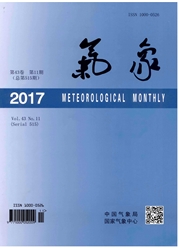

 中文摘要:
中文摘要:
利用多普勒天气雷达、风廓线雷达、加密自动站、浮标站、常规探空和地面等多种观测资料,对2014年12月山东半岛东部一次冷流暴雪的发生、演变特征进行了分析。结果表明:(1)此次冷流暴雪发生时渤海上空500hPa气温在-36℃左右,850hPa气温在-18~-16℃,海面西北风〉12m·s^-1。700hPa以下为混合层,1000~700hPa混合层内近乎饱和。浮标站资料显示海表面到850hPa的较大海气温差和山东半岛较强海岸锋是产生暴雪的重要原因。(2)暴雪发生时雷达回波的PPI在30~45dBz;每6min雷达回波垂直剖面显示1个较强降雪回波单体持续时间可达到1h。雷达资料反演0.8km以上风场表明:强降雪回波位于NE与Nw风辐合区的东侧,冷流暴雪的水平风辐合主要在3km以下。风廓线雷达资料表明:暴雪发生前在100m以下有弱西风存在,暴雪发生时150~700m弱的西北风(〈6m·s^-1)和低层切变线辐合的共同存在,有利于降雪对流的加强;当这种弱西北风层消失后,降雪即停止。
 英文摘要:
英文摘要:
Using multiple data of Doppler weather radar, wind-profiling radar, automatic station, buoy sta- tion, conventional sounding and surface observation, the characteristics of occurrence and evolution of one snowstorm event in the east of Shandong Peninsula in December 2014 are analyzed. The results show that firstly, over the Bohai Sea, the 500 hPa temperature is --36℃ or so, the 850 hPa temperature is in the range of --18-16℃, the direction of the Bohai Sea surface wind is northwest and its velocity is more than 12 m ·s^-1 when the snowstorm occurred. The conventional sounding data show that the mixing layer is below 700 hPa and the atmosphere in the 1000--700 hPa mixing layer is almost saturated. The buoy sta- tion shows that the larger air-sea temperature difference bewteen the Bohai Sea surface and 850 hPa, and the stronger coastal front in Shandong Peninsula are the critical causes for the snowstorm. Secondly, dur- ing the snowstorm, the radar reflectivity is between 30 and 45 dBz. The analysis on the radar echo vertical section of the re{lectivity every 6 min reveals that a strong snow echo cell can maintain for one hour. The velocity of Doppler data shows that the distribution of heavy snow cells occurs in the east area of the conve- rsence zone between NE and NW winds. The horizontal wind convergence of cold-flow snowstorm mainly exists below 3 km. The wind profile radar data show that there is a low-level western breeze under 100 m before the formation of the snowband. The existence of weak northwestern wind in 150--700 m height and the convergence of low-level shear line are beneficial to strengthening the convection of snowstorm. When such weak northwestern wind layer disappears, the snowstorm ends.
 同期刊论文项目
同期刊论文项目
 同项目期刊论文
同项目期刊论文
 期刊信息
期刊信息
